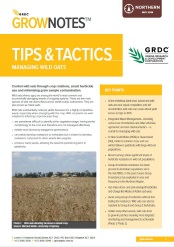Tips & Tactics: Managing wild oats
Tips & Tactics: Managing wild oats
Published: 19 Jun 2018
Wild oats (Avena spp.) are among the world’s most common and economically damaging weeds of cropping systems. Wild oats substantially reduces yields because it is a highly competitive weed, especially when emerging with the crop.
Wild oat plants are well adapted to infesting crops. Control wild oats through crop rotations, smart herbicide use and minimising grain sample contamination.
Key Points
- At the individual plant level, wheat and wild oats are near equal competitors and left uncontrolled, wild oats can cause wheat yield losses as high as 80%.
- Integrated Weed Management—including correct use of herbicides and other effective agronomic and non-chemical tactics—is crucial for managing wild oats.
- In New South Wales (NSW) or Queensland (Qld), rotate to summer crops and use winter fallow in paddocks with large wild oat populations.
- Group A herbicide resistance has been present in Australian populations since the mid-1980s. In the past 2 years Group A resistance has exploded in area and frequency in the Northern Region.
- Use mixes of pre- and post-emergent herbicides and change the Modes of Action each year.
- Avoid using Group A herbicides without first testing for resistance. Wild oats can also be resistant to Group B and Group Z herbicides.
Download PDF
Region: North
GRDC Project Code: UA00124, GOA0002, NGA00001, US00084.,

